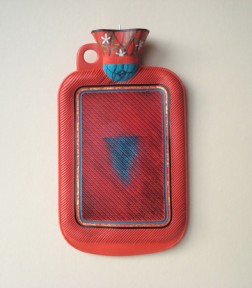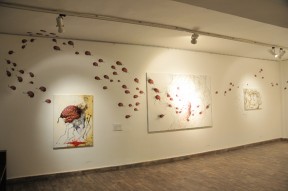You could have stepped into a science lab. A hand drawn human brain connected to jumbled up wires sits precariously on one wall. Several similar drawings across the remaining space create an anatomical collage of the brain’s journey and make you wonder about the complexities of human mind.
But this is an art gallery and New Zealand-based artist Nandita Kumar has converted the gallery space into her private lab for a debut show titled Let The Brain Fly. While an enlarged and bloated brain finds centre stage in Kumar’s works, she converts the brain into a housefly that moves all over the gallery wall. Kumar reveals that she combined the two images as a random inspiration when thousands of flies sat on her window sill as she was drawing a brain.
“Our head is becoming bigger and bigger. It is as if we are now living inside our heads but at the same time, we are not taking good care of ourselves, our environment. You don’t know who is in control, we or our emotions.” A visual story-board, Kumar’s artwork leads ‘the brain’ through processes of evolution and mutation, beyond the constructs of the material world. What adds to the impact here is the material she uses – brain maps, wires, projectors, electrical circuitry – to create an entire neuron-scape inside the gallery.
Just a few years ago, all that ‘new media art’ meant was videos, animation and graphics but now the term has come to encompass a staggering range of materials – glass, stone, leather, feather, jewels, cloth, buttons, plastic and all which we thought was just garbage – that has not only found enthusiastic collectors but also brought into limelight a whole new generation of artists not afraid to experiment.
And this art is being validated. One of Mumbai’s top galleries, Sakshi Gallery, willingly gambled to showcase new media artists in its 20thanniversary show in the capital whose art palate is far more conservative than the hipper Mumbai. Even at the last edition of India Art Summit – where one would expect only the time-tested to have fetched high prices – it is reported that five crore worth of new media was sold. At Latitude 28 in New Delhi, a recent show on the Pill (the contraceptive) has hot water bottles, leather whips, pill boxes and bindis – all as varied references to women’s angst the world over.
 In this show, Tazeen Qayyum’s installation-based mixed media work of 10 rubber bottles titled It’s Complicated, a term universally recognized in branding relationships thanks to popular social media sites such as Facebook and Friendster, is created by hand painting on old-fashioned, rubber hot-water bottles.
In this show, Tazeen Qayyum’s installation-based mixed media work of 10 rubber bottles titled It’s Complicated, a term universally recognized in branding relationships thanks to popular social media sites such as Facebook and Friendster, is created by hand painting on old-fashioned, rubber hot-water bottles.
Says Qayuum: “Hot-water bottle is a metaphor for the female body, along with the association of comfort and pleasure with the object itself.” Accompanying this work, Tazeen also shows a sculptural piece titled Thee Only do I Love created using commercial ice bags. Each canvas bag is painted with images of flowers, such as Myrtle, Purple Violet and Jonquil which, in Western symbolism, are associated with fidelity in love and faithfulness.
On the other hand, US-based Jaishri Abhichandani’s wall mounted installation, titled No Way Home, made of leather whips, paint, wire and jewels, focuses on the fetishizing of the female body, and feminine identity. This piece uses a number of whips, which are wound together, and covered in crystals. This work can also be understood as a contemporary reworking of her one of her most controversial sculptures, Roe vs. Wade, which takes its title from the American Abortion law of 1973. The pink whips, nailed to the wall, and covered in jewels, came together to form a shape that fell somewhere between a bullhead and a diagram of a uterus. This work was at once a nod to the Wild West and India’s scared cows, with the sign of female reproductive anatomy enmeshed in between.
“Yes, there is a perceptible change in collector’s choice. People are willing to invest and take risks on upcoming artists who are experimenting in new media,” says Bhavna Kakar of Delhi’s Latitude 28 gallery which promotes new media art.
Baroda, in fact, is in sharp focus for its new media-driven art practice. Take for example Baroda artist Ajay Kanwal’s Yellow Master Stone installation of a vertical glass box filled with water and floating pebbles. “New media is not as effortless as it looks,” says the artist, explaining that the floating ceramic stones in his work, inspired by the mythological Ramayana, are made in a way that their lesser density allows them to float on water.
Another rising star from Baroda, Siddhartha Kararwal’s intriguing creative practice has always revolved around the usage of ordinary everyday material like plastic bags, foam sheets, firecrackers, cardboard, iron, copper, clay and plaster of Paris. In a work titled Skinned, for instance, he uses a blanket, rawly burnt with petrol and then dyed, to create a story about an urchin who lost his life to the bitter cold in Delhi, or the quirkier 7-feet high Whackassmade of heaped donkey-like shapes stuffed with cotton and old rugs. Kararwal’s colleague Nityananda Ojha’s sculpture titled Masturbation made of junk jewellery, M Seal and acrylic was talk of the town for several weeks when it was shown in Delhi.
Irreverent yet interactive – this seems to be hallmark of the current new media art wave. Thukral & Tagra – India’s new media export to the West – shot to international fame with their safe sex campaign using brazenly titled T Shirts, underwear and flips flops, while also giving condoms an arty avataras part of their quirky BoseDK project.
Curator Avni Doshi, who has curated the show on the Pill, says that new media allows artists to be cheeky while tackling serious issues. For instance, Delhi-born, London-based artist Vinita Khanna, questions consumerism using plastic bottles, wires and glass shards, that are used as props, in both digitally created photographs and live installations.
 Khanna’s work is getting a positive response in India – she was shown by Gallery Espace in Delhi – but she is wary of excessive experimentation as well. “Medium is not important. What matters is that the art should connect with people.” A viewpoint echoed by Bhubaneshwar based artist Kanta Kishor Moharana who is now found in every group show that celebrates new media. He has been making life-like newspaper models out of marble and stone with hand-etched newspaper headlines focusing on child labour, environment and crime since 2005. He says: “It was much tougher for me to show this work when I started out but now this is my best-selling series.” Mumbai’s Smriti Dixit is celebrated for her abstract ‘floral balls and bouquets’ created out of strips of dresses, threads, wires, clothes’ tags, sponge, brass, rivet and junk.
Khanna’s work is getting a positive response in India – she was shown by Gallery Espace in Delhi – but she is wary of excessive experimentation as well. “Medium is not important. What matters is that the art should connect with people.” A viewpoint echoed by Bhubaneshwar based artist Kanta Kishor Moharana who is now found in every group show that celebrates new media. He has been making life-like newspaper models out of marble and stone with hand-etched newspaper headlines focusing on child labour, environment and crime since 2005. He says: “It was much tougher for me to show this work when I started out but now this is my best-selling series.” Mumbai’s Smriti Dixit is celebrated for her abstract ‘floral balls and bouquets’ created out of strips of dresses, threads, wires, clothes’ tags, sponge, brass, rivet and junk.
“If it makes you scratch you head, it is art,” was curator Swapan Seth’s famous one liner that opened the Sakshi show. New media art makes you do that and much more – it also makes money now!
Poonam Goel is a freelance journalist and has covered the arts for over 15 years. She contributes on visual arts for various newspapers, magazines and online media. More about her on Story Wallahs. Write to her @ poonamgoel2410@gmail.com






